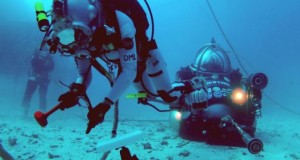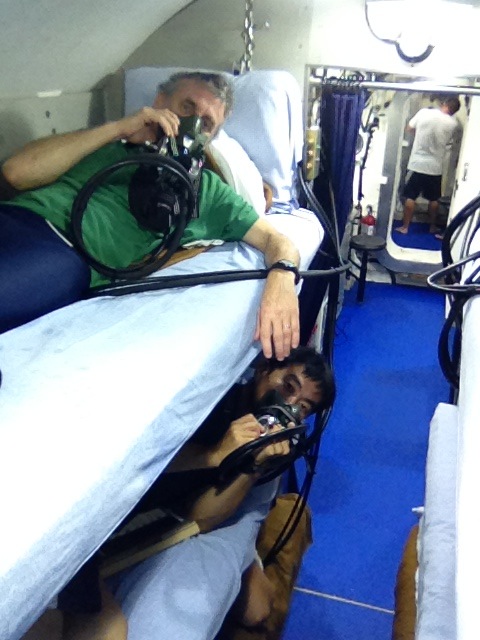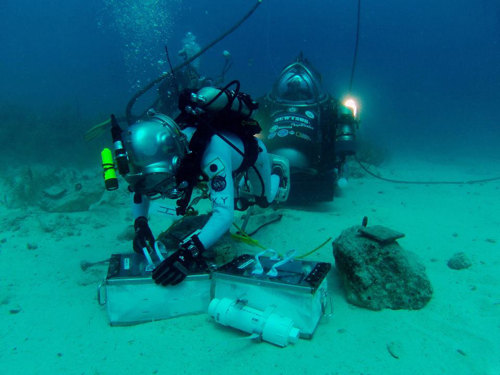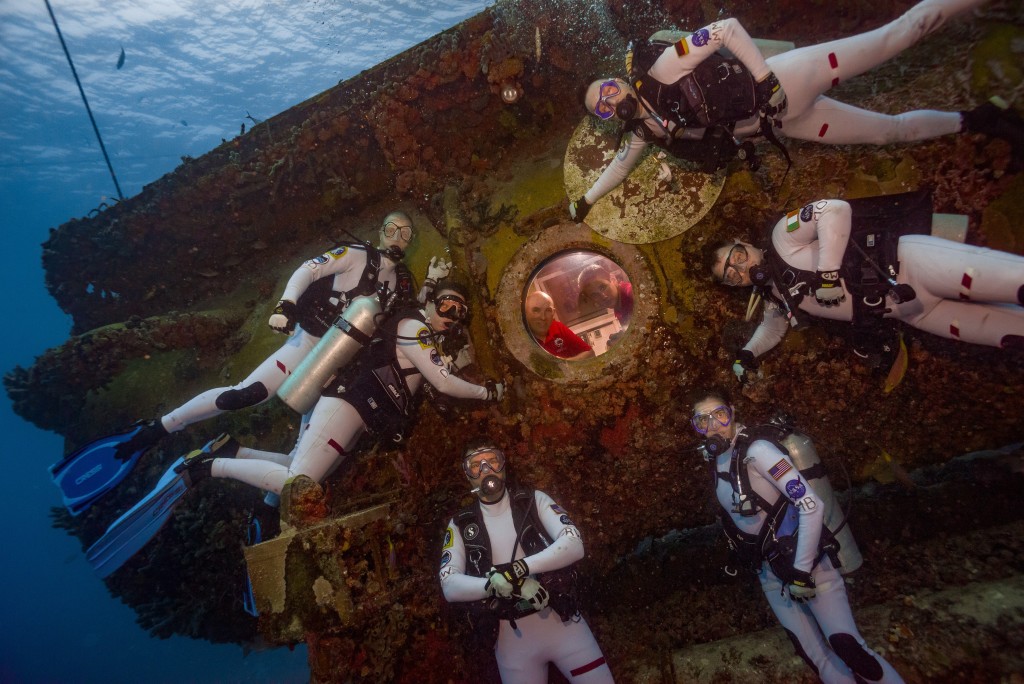NEEMO 21 is now conducting operations under 15-minute communication time delay – including science and exploration dives! Due to the distance between Earth and Mars, communications can be between 4 and 24 minutes one-way, depending on the orientation of the planets. Aquanaut Dr. Marc O Griofa says “you are almost chasing the past, present & future all at the same time” while coordinating interactions between Mission Control and the crew. The goal is to figure the tools and protocols we need to effectively communicate under time-delayed conditions when astronauts explore Mars.
Category: Neemo
International Aquanauts
NEEMO 21 has an international crew, similar to the International Space Station. Our aquanauts this mission are from United States, Germany, Ireland and South Africa.
 NEEMO 21 Aquanauts: Reid Wiseman (NASA), Megan McArthur (NASA), Matthias Maurer (ESA), Marc O Griofa (Teloregen/VEGA/AirDocs), Noel Du Toit (Naval Postgraduate School), Dawn Kernagis (Institute for Human & Machine Cognition), and FIU Habitat Technicians Hank Stark and Sean Moore.
NEEMO 21 Aquanauts: Reid Wiseman (NASA), Megan McArthur (NASA), Matthias Maurer (ESA), Marc O Griofa (Teloregen/VEGA/AirDocs), Noel Du Toit (Naval Postgraduate School), Dawn Kernagis (Institute for Human & Machine Cognition), and FIU Habitat Technicians Hank Stark and Sean Moore.
Deep Sea for Deep Space: NASA Astronauts Train For Future Missions
A group of astronauts, engineers and scientists ventured to the bottom of the Atlantic Ocean on July 21 to prepare for future deep space missions and the journey to Mars. Isolation at the bottom of the ocean simulates life and work for astronauts in microgravity, making the 16-day mission an analog for future space exploration. They will test tools and techniques for future spaceflight and will conduct simulated spacewalks outside of their undersea habitat, Aquarius.
Inside Aquarius, the international crew will conduct a variety of research and operations studies, such as testing a mini DNA sequencer that NASA astronaut Kate Rubins also will be testing aboard the International Space Station, and a telemedicine device that will be used for future space applications. During their simulated spacewalks, the crew will collect samples for marine biology and geology studies, test software for managing operations, and participate in a coral restoration project. Throughout many of these tasks, the mission will also test communications delays similar to those that would be encountered on a mission to Mars.
“NEEMO 21 astronauts and crew will pioneer complex tasks on the seafloor utilizing the most advanced underwater navigation and science tools which are methodically choreographed to mimic a Mars exploration traverse,” NEEMO Project Lead Bill Todd said. “Equipment can fail, communication can be challenging and tasks can take longer than expected. Other tasks go just as planned. All cases are equally beneficial. It’s how we learn and how we are able to assemble all of this together so that someday we’re prepared for the unexpected when we are living on and traversing the Martian surface.”
NASA Astronaut Reid Wiseman will command the first eight days of the NEEMO 21 mission. Wiseman flew in space as part of Expedition 40/41 in 2014, spending 166 days living and working aboard the International Space Station. Wiseman was a naval aviator and test pilot prior to joining NASA in 2009.
NASA Astronaut Megan McArthur will command the second half of NEEMO 21, and will live in the habitat for the entire 16-day mission. McArthur flew on the STS-125 shuttle mission in 2009, and has served as a Mission Control spacecraft communicator for both space shuttle and space station missions. Prior to joining NASA, McArthur obtained a doctorate in oceanography at Scripps Institution of Oceanography.
Joining McArthur for the entire 16 days is ESA (European Space Agency) Astronaut Matthias Maurer. For the first eight days, Marc O’Griofa, chief medical and technology officer for Noninvasive Medical Technologies Inc., also will join Wiseman, McArthur and Mauerer. For the second half of the mission, McArthur and Mauerer will be joined by Florida Institute for Human and Machine Cognition Research Scientist Dawn Kernagis and Naval Postgraduate School Researcher Noel Du Toit.
The NEEMO crew and two professional habitat technicians will live 60 feet below the surface of the Atlantic Ocean in Florida International University’s Aquarius Reef Base undersea research habitat 6.2 miles off the coast of Key Largo, Florida. NEEMO 21 is supported by the Human Health and Performance Directorate at NASA’s Johnson Space Center with funding from ESA and partnerships with the Naval Postgraduate School, Embry Riddle Aeronautical University, Vega Telehealth, TeloRegen, and Johns Hopkins.
For more information about NEEMO, the crews and links to follow the mission on Facebook and Twitter, visit: www.nasa.gov/neemo.
For more information on other analog missions NASA is conducting, go to www.nasa.gov/analog
Image Credit: NASA/Karl Shreeves
NASA selects Irish doctor to monitor aquanauts
Astronauts, engineers and scientists will spend three weeks undersea off Florida

An Irish doctor has been selected by US space agency Nasa to monitor the health of six astronauts, engineers and scientists who are due to spend three weeks in an undersea research station off the Florida coast.
NUI Galway-based clinician Dr Derek O’Keeffe will apply his telemedical skills to check remotely on the wellbeing of the six aquanauts – one of whom is a fellow Irish man, Marc Ó Gríofa from Clonee, Co Meath.
Dr Ó Gríofa, who has a PhD in biomedical engineering, will live some 20 metres under the Atlantic Ocean as part of the Nasa extreme environment mission operations (NEEMO) project.
Dr O’Keeffe holds dual biomedical engineering and medical qualifications, and is an expert in remote monitoring technology, with experience in prior spaceflight and extreme environment missions.
He will oversee the physiological parameters of the six participants, and will run several staged health emergency events to help develop protocols on crisis response in remote conditions.
“The Aquarius habitat and its surroundings provide a convincing analogue for space exploration,” Dr O’Keeffe said.
“Nasa is also carrying out similar missions in other extreme environments, such as deserts, icefields and volcanoes around the world,” he said.
Telemedicine allows health care professionals to evaluate, diagnose and treat patients in remote locations using two-way video, email, smart phones, wireless tools and other forms of telecommunications technology.
Telemedicine is already being used for monitoring chronic disease at home, and it can also provide remote healthcare in “medically underserved” areas, he said.
Ultimately, monitoring of people with diabetic or cardiac conditions can pre-empt emergency hospital admissions, he says.
“Fast-forward 10 years, we would envisage that it would be the standard of care for patients to have home monitoring of physiological data for certain chronic diseases, and equally for all hospitalised patients to have continuous monitoring and remote review,” he said.
Dr O’Keeffe is due to give a public talk on telemedicine at NUIG’s clinical science institute on July 22nd, and will participate in a live public video-link with the aquanauts, who will take to their sub-sea environment from July 18th.
By Lorna Scoggins, The Irish Times
http://www.irishtimes.com/news/ireland/irish-news/nasa-selects-irish-doctor-to-monitor-aquanauts-1.2720869
NEEMO 16: Decompression Day
By aquanaut Steve Squyres (Cornell University)
It’s deco day.
Decompression is a strange experience. It happens at the end of every mission at Aquarius, and it’s happening to us as I write this.
One of the many ways in which life in Aquarius is like life in space is that you can’t just go home when you want to. In space, the reason is obvious… you’re in space. In Aquarius, the reason is less obvious, but just as important. If you simply swim up to the surface after a stay in Aquarius, you’ll get what divers call “the bends”.
 Image at right: Aquanauts Steve Squyres (top bunk, Cornell University) and Kimiya Yui (bottom bunk, JAXA) during NEEMO 16 decompression.
Image at right: Aquanauts Steve Squyres (top bunk, Cornell University) and Kimiya Yui (bottom bunk, JAXA) during NEEMO 16 decompression.
Down here in the habitat, the atmospheric pressure is two and a half times higher than at the surface. We keep it that high to keep the water out — the pressure of the air prevents water from coming inside.
The inconvenient thing about living at that pressure, though, is that it forces a lot of nitrogen into your body. Air is mostly nitrogen, and at that pressure the amount of nitrogen that works its way into your body tissues is substantial. Come to the surface very slowly, and you’re fine… the nitrogen can leak out slowly and safely. Come up fast, though, and it’s like opening a bottle of soda… bubbles of nitrogen form in your blood. And that can be very bad news.
To ascend safely from Aquarius takes about 18 hours, which is an impractically long time to be moving up through the water column in dive gear. So what we do instead is seal the habitat up tight, and then slowly pump air out, reducing the pressure bit by bit. Over 18 hours the pressure goes slowly down to normal surface pressure.
As I write this, it’s about 10:30 PM on mission day 11. The gauge in the habitat says that we’re at a pressure equivalent to 18 feet of seawater. By 7:45 tomorrow morning, that’ll be down to zero feet, and we’ll be ready to go to the surface safely.
Except for one thing — we won’t be able to open the door.
With low air pressure inside the habitat, the enormous pressure of the seawater outside holds the door firmly shut. The only way we can get out is to bring the pressure back up to what it was before decompression… a process called “blowdown”. Blowdown is quick. The air valves are opened, the air rushes in, and before long things are back to normal. It’s noisy, too.
And then it really is time to go. Once blowdown has happened, all that nitrogen that was so carefully purged from our bodies begins to leak back in again. So at that point it’s like a fire drill… out to the wet porch, into our scuba gear, and up to a waiting dive boat in just a few minutes. It’s a strange experience.
And then we’ll be able to see the sky again, for the first time in almost two weeks. That will be strange too.
Learn more about NEEMO at www.nasa.gov/neemo.
NEEMO 16 Science: Explore, Report, Collect
By Aquanaut Steve Squyres (Cornell University)
Today was the coolest day of the mission for me.Today we moved from engineering to science.
Engineering and science are different things. Engineers are inventors. Theirjob is to design and build things that people can use. Engineering requiresenormous creativity, and creativity of a very special kind: creativity that iscoupled with practicality. The stuff engineers build actually has to work.
 Image at right: Aquanaut Kimya Yui (JAXA) collects chipping samples from a rock simulating an asteroid boulder.
Image at right: Aquanaut Kimya Yui (JAXA) collects chipping samples from a rock simulating an asteroid boulder.
Scientists, on the other hand, are seekers of truth. Their job is to figure outhow the world works. Science requires intuition, knowledge that is based on thework of many other scientists, and sometimes a fair amount of luck.
What we’ve been doing at NEEMO so far has been engineering in the service ofscience. We’ve been testing out hardware that was designed and built byengineers, using the procedures they recommended to us. Our job has been tofind out what works and what doesn’t, and to relay that information back to theengineers. They build, we test, they make changes, and we test again. Someday,on an asteroid, the stuff that works best is going to be used to do science onthat asteroid. We’ve been doing the engineering work to help make that futurescience possible.
But today was different. On our EVAs today we had no engineering tests toperform. Instead, our job was to explore, to report what we found back toMission Control, and then to collect the samples they wanted us to collect.
The cool thing about this is that when we went out the door we didn’t know whatwe were going to find. The surface of our “asteroid” isreconfigurable, and the day before some clever people had gone out there, setup some challenges for us, and had not told us what they’d done. It was up tous to figure it out.
Just like any other field scientists, we started with reconnaissance, flyingabove the surface with jetpacks and reporting back to Mission Control what wediscovered. On the spot, they came up with a science plan for us, just as wouldhappen with a crew at an asteroid. And then it was up to us to use all thetools we had at our disposal, in whatever way we thought best, to carry outthat science plan.
When Kimiya and I did this on our morning EVA, we relied a lot on our jetpacks.Dottie and Tim made more use of the translation lines and the booms to do theirsampling. Both approaches worked, but in different ways. It was reallyinteresting to debrief after dinner, and compare notes on our experiences.
But most of all, these EVAs felt like real scientific field work to me.It was a taste of how it’s really going to be to explore an asteroid and Ithink it was a big step forward for NEEMO and NASA, and something that’ll takeus a significant step closer toward doing it for real someday.
To learn more about NEEMO visit www.nasa.gov/neemo.


